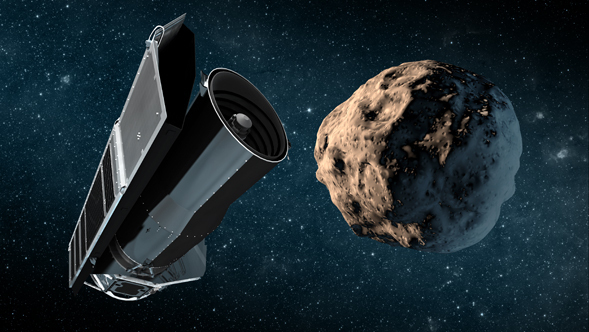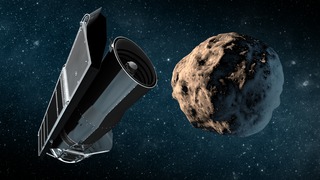
News Release • April 3rd, 2014 • feature14-07 •
Our Solar System is swarming with asteroids and comets. Although astronomers have identified many thousands of these space rocks, new candidates turn up all the time; some small fraction of which might even pose a threat of colliding with Earth. Helpfully, telescopes sometimes serendipitously capture images of asteroids and icy, comet-like objects prior to their formal discovery. These past observations can aid with nailing down an object's path around the Sun, as well as offering clues about its shape and surface characteristics
Now, a new software tool that lets astronomers quickly comb through existing datasets for handy "precovery" observations is being applied to the 10-year archives of NASA's Spitzer Space Telescope. The tool allows for the precovery of objects of interest by picking through Spitzer's voluminous archives essentially backwards in time.
"The precovery software works by calculating where a particular object was, or should have been, at various times in the past," said Steve Groom, a task manager at the Infrared Processing and Analysis Center (IPAC) at Caltech. "Then the software searches a selected image archive for images that were taken in the right place at the right time."
Groom and colleagues originally developed the software, informally known as MOST (Moving Object Search Tool), back in 2010 for the dedicated asteroid- and comet-hunting mission NEOWISE (Near-Earth Object Wide-field Infrared Survey Explorer). The developers created MOST, however, with the vision of adapting it to various datasets from spacecraft and ground-based observatories. Besides Spitzer, MOST has also been applied to Caltech's Palomar Transient Factory's datasets, with other mission applications planned.
Making dense archives such as Spitzer's easily accessible should add to the wealth of small Solar System body information obtained by NEOWISE. For instance, observations of objects at varying locations in their orbits, where sunlight glints off them at distinct angles like the phases of the Moon, can reveal characteristics about their shapes and textures.
"We can look for variations in brightness over time or owing to different viewing geometries, for example, by capturing the object in different phases of illumination by the Sun or orientations as it spins," said James Bauer, a research scientist at the Jet Propulsion Laboratory (JPL). "We can infer details regarding its surface roughness or shape from these combined datasets from two or more instruments."
Crucially, seeing an object at different points in time also lends a hand in calculating its trajectory through space, known as an "ephemeris."
"When you find a new moving object, you need to observe it several times to really get an accurate path for it, which helps you predict accurately where it's going to be in the future," said Lisa Storrie-Lombardi of the Spitzer Science Center at the California Institute of Technology (Caltech). "Spitzer has a ten-year catalog of observations, so if Spitzer saw your object by chance a while back, that gives you the possibility of having a much longer baseline for determining an ephemeris."
While Spitzer's datasets do not cover the whole sky, the MOST software tool can assist in finding any asteroids and comets previously hidden in the archive. Hints of a possible precovery have in fact already emerged. An object appearing to be the asteroid 2010 SO16, originally discovered by NEOWISE's precursor mission, WISE, in 2010, has been preliminary identified in Spitzer data from 2005. The approximately quarter-mile-diameter object co-orbits with Earth in a horseshoe-shaped path, tagging along with our planet as we orbit the Sun together. Confirmation of this sighting, along with others that might lie in the Spitzer archives, could highlight an unexpected benefit for the Spitzer science program.
NASA's Jet Propulsion Laboratory, Pasadena, Calif., manages the Spitzer Space Telescope mission for NASA's Science Mission Directorate, Washington. Science operations are conducted at the Spitzer Science Center at the California Institute of Technology in Pasadena. Spacecraft operations are based at Lockheed Martin Space Systems Company, Littleton, Colorado. Data are archived at the Infrared Science Archive housed at the Infrared Processing and Analysis Center at Caltech. Caltech manages JPL for NASA.





